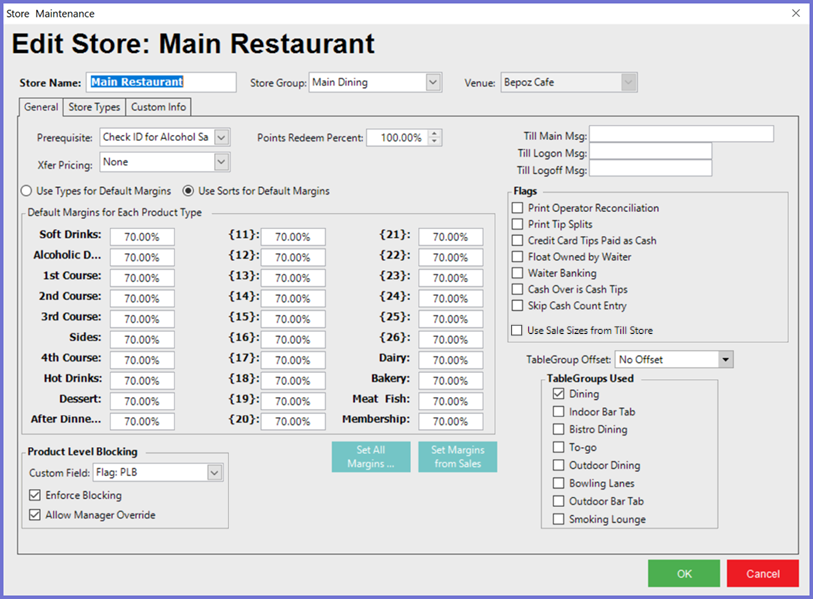Configuration Option/s
|
Description
|
Visual/s (if applicable)
|
| Prerequisite |
- All SmartPOS Workstations in this Store will need to meet any Prerequisite that is set here prior to selling Products
- Prerequisites are configured via Operational Setup in BackOffice
|
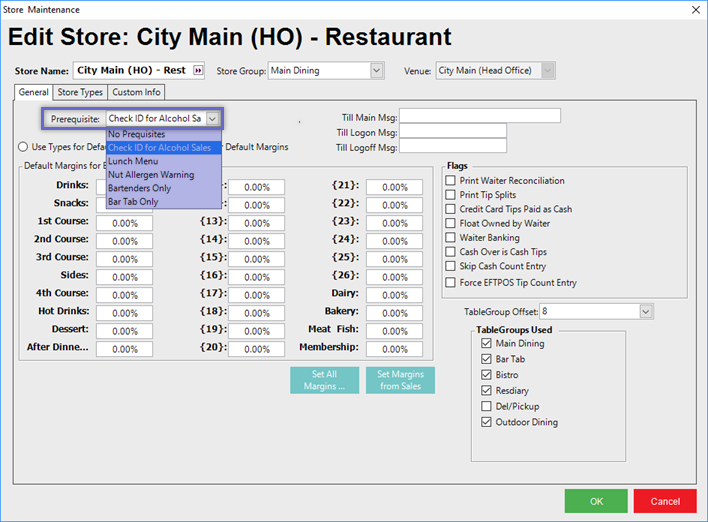
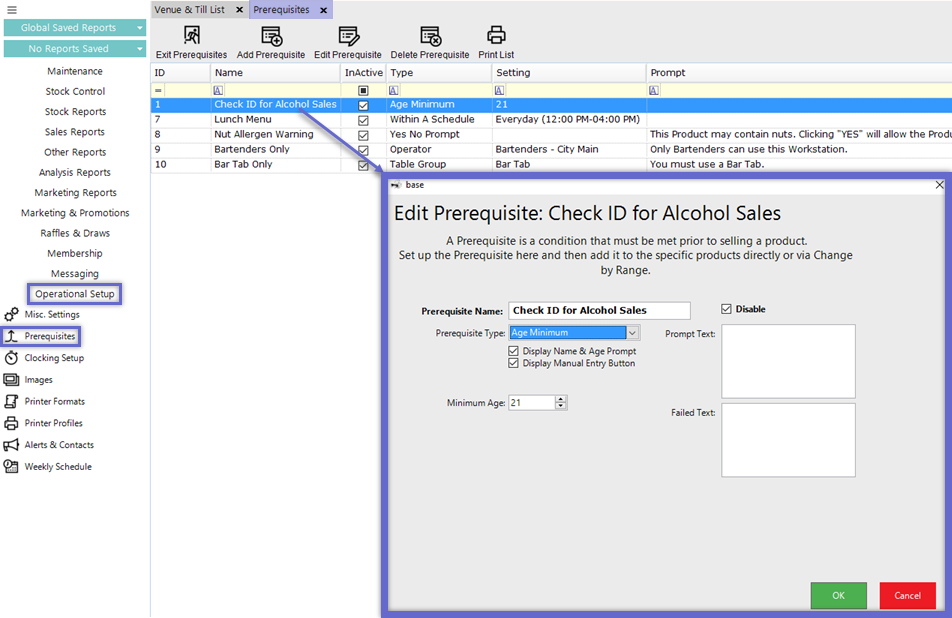
|
| Points Redeem Percent |
- This offers the ability to set - on a Store level - a Percentage that affects the Points required when an Account is Redeeming Points for a purchase utilizing the Item Use Points Till Function
- This is the percentage that a Product's Sale Price is multiplied by to calculate the Redeem Points required to purchase a Product
- E.g., if a Product costs $5 and this is set to 100%, then 5.00 Points will be Redeemed to purchase the Product using Points
- This is by default set to 100.00%; if left alone, the Redeem Points calculation is unchanged
- Alternatively, set as 0.00% to disallow Redeem by Points in the Store
|
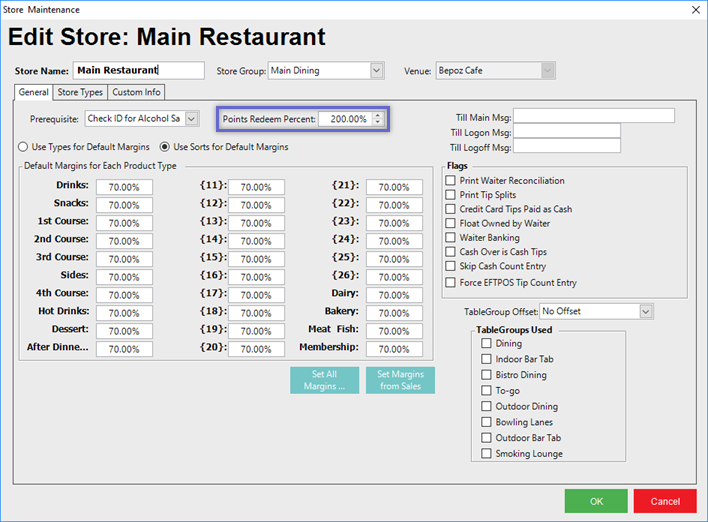
|
| Xfer Pricing |
- This drop-down allows for changing the Cost that is used for Product/s when being Transferred to this Store
- While this is also supported at the Venue-level, this gives greater versatility to a mixed operation of warehouse/retail organisation by permitting different stores to have different cost models for Stock Transfers
- A use case would be an organisation where Stock being Transferred from the warehouse to Retail outlets should be costed at a higher price than the warehouse's actual cost
- If the receiving store has Xfer Pricing set to None, then Pricing will default to the Venue's Xfer Pricing setting for transfers
- If the receiving store has Standard Cost set, then the Standard Cost of transfers will be used
- Otherwise, if set to a Send or Recv Store Price, then the Price from the selected Store's Price Level will be used
|
|
| Till Main Msg |
- Any text entered into this field will display as a Message between Transactions on 2-line vacuum fluorescent customer screens on SmartPOS Workstations in this Store
- If it is larger than the display width, it will scroll continuously
|
|
| Till Logon Msg |
- Any text entered into this field will display as a Message when an Operator logs on to a SmartPOS Workstation on 2-line vacuum fluorescent customer screens in this Store
- By default (if no text is entered here), the Operators' name will display when logging on
|
|
| Till Logoff Msg |
- Any text entered into this field will display as a Message when no Operator is logged on to a SmartPOS Workstation on 2-line vacuum fluorescent customer screens in this Store
- By default (if no text is entered here), nothing will be displayed when no Operator is logged on
|
|
| Use Types/Sorts for Default Margins & Default Margins for Each Product Type |
- This section allows for setting the Default Margin that applies to Stock in the Store
- The first decision is whether the Default Margins are set by the Product Type or the Sort Type
- Select either Use Types for Default Margins or Use Sorts for Default Margins
- Whichever one is selected will auto-populate the Margin fields to represent the System's Product Types or Product Sorts as are defined in Global Settings
- The purpose is so that when a new product comes into Stock but the Inventory has not yet been entered into the Stock System the System will use the Margin that is set for the Type or Sort so that all Sales of the Product will show that assigned group Margin and give valid Profit Reporting until the Stock is entered and the System has the correct Product Cost to operate with
- At that time the System will automatically make a correction back in time for the Margin that was Reported and the actual Margin it should have been based on the actual Cost
- The Margins can be set automatically by selecting either the Set All Marginsbutton or the Set Margins from Sales button
|
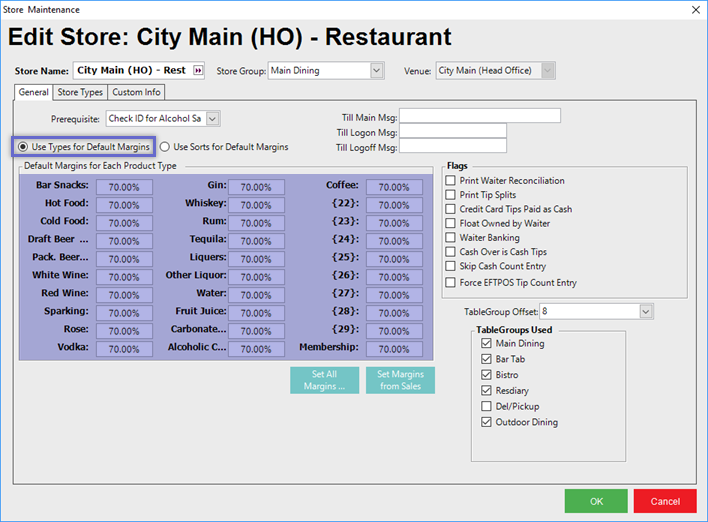
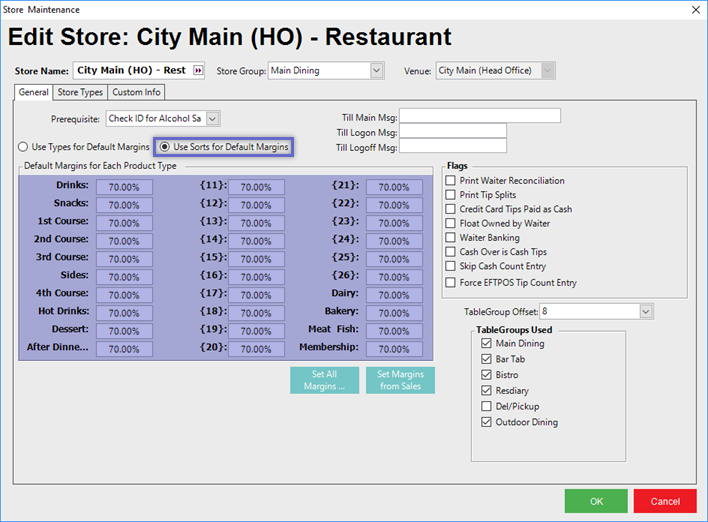
|
| Set All Margins |
- Selecting the Set All Marginsbutton will open a small window with a number pad which allows for entering the Default Margin Percentage to be applied to all of the above fields
- By default, the Margins will be set to 70% when using this function
|

|
| Set Margins from Sales |
- As an alternative to selecting the Set All Margins button, if using the Set Margins from Sales button the system will analyze what the Margins are by the chosen category and set them automatically
- The Default Margins will be set according to the Last Month's Sales from all Tills in the Store
|
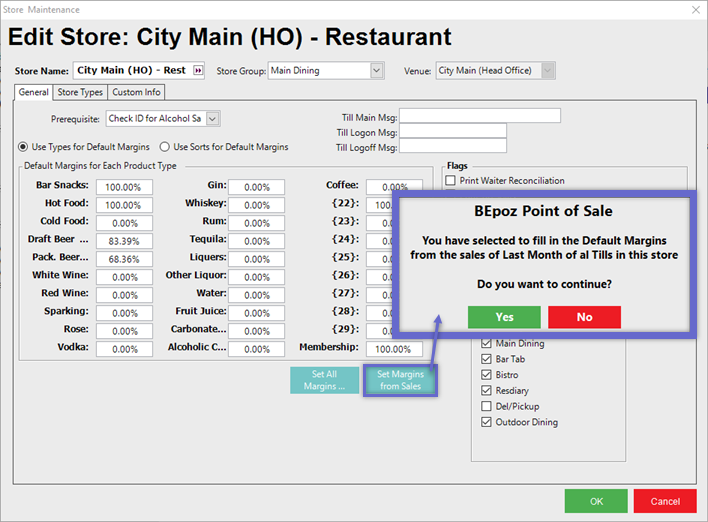
|
| Product Level Blocking |
- This feature allows the restriction of certain products whose custom field info is defined here
- Enforce Blocking flag enables the blocking of restricted items
- Allow Manager Override flag enables Override of sale including restricted items
|

|
| Print Waiter Reconciliation |
- If this flag is enabled then Waiter (Cashier) Reconciliation will be included on the Till Balance
|
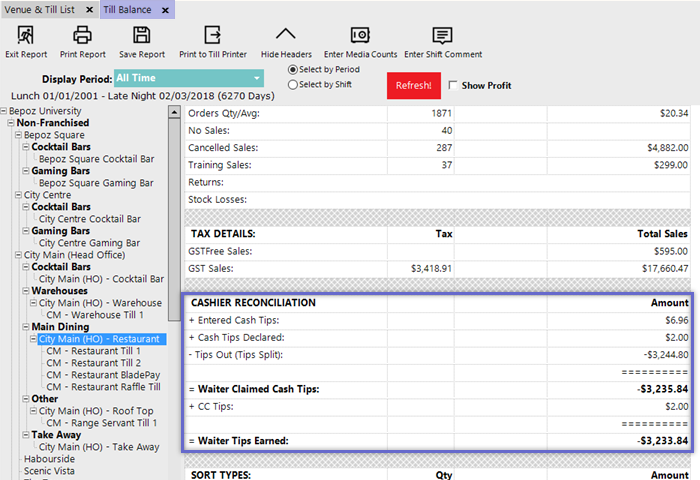
|
| Print Tip Splits |
- When this flag is enabled then Tip Splits (configured in the Store's Venue's Venue Maintenance 'Tables' Tab) will be included on the Till Balance
|
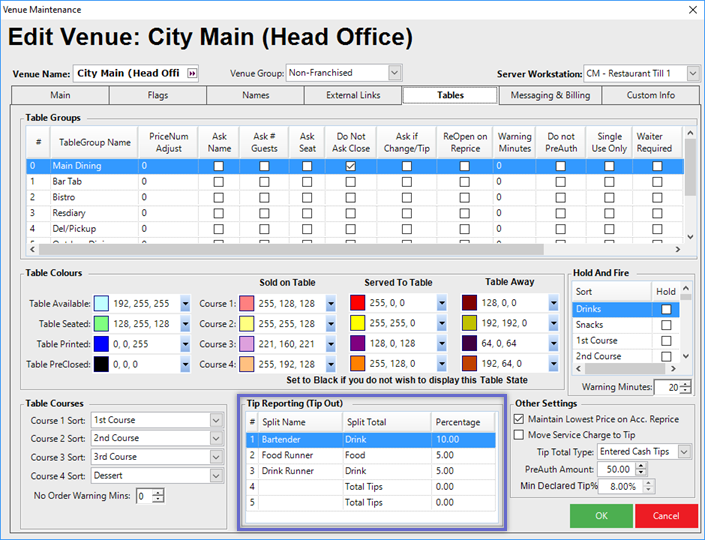
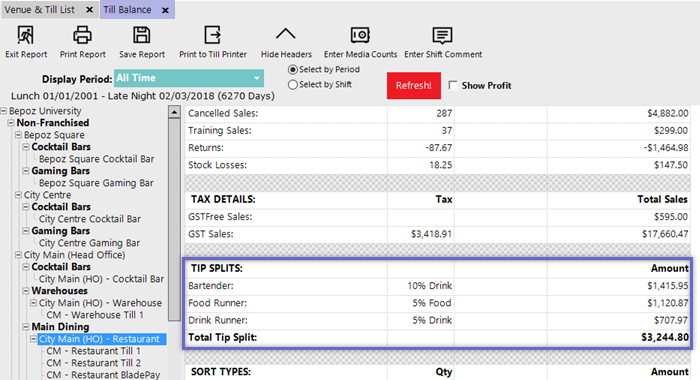
|
| Credit Card Tips Paid as Cash |
- If this flag is enabled then Credit Card Tips will be paid out to the Waiter as Cash at the end of each Shift
|
|
| Float Owned by Waiter |
- Enabled this flag if the Float entered is the actual Waiter's money
|
|
| Waiter Banking |
- When Waiter Banking is used and therefore this flag is enabled, each Waiter holds their own Money and pays the Reported Amount (usually Sales sans Tips) to the Store at the end of their Shift
|
|
| Cash Over is Cash Tips |
- If this flag is enabled then when entering the Waiter Total Cash at the end of a Shift, if the Waiters' Total Cash is more than Cash Sales, the difference is classed as Total Cash Tips
|
|
| Skip Cash Count Entry |
- When this flag is enabled then when entering Media Counts at the end of a Shift, Cash Counted will not be included when progressing through the process of entering Counts
- This can be used if Cash is counted away from the Till and entered into Media Counts in BackOffice
|
|
| Use Sale Sizes from Till Store |
- When the flag is enabled, prodstore sizehideflags are used from the original store when a prodstore redirect is used
- When the flag is disabled, the prodstore sizehideflags work as they used to
|
|
| Force EFTPOS Tip Count Entry |
- This defines if EFTPOS Tip Count Entry is available in SmartPOS when entering Media Counts
|
|
|
TableGroup Offset
|
- This drop-down allows the Store to use the configurations of the Venue's TableGroups, yet have a separate Offset to other Stores in the Venue (or share an Offset with other Stores)
- This Store may wish to use an Offset where each Table Group would keep the same configurations as those that are set up in Venue Maintenance but would have different Table Group Numbers
- The Offset of Table Group Numbers starts with 8 (so the first possible Offset would use Table Groups #8 - #15) and increases by 8 for each incremental Offset up to #240 - allowing for 30 TableGroup Offsets
- So, if the Store uses TableGroup Offset by 8, then it will utilize Table Groups #8 through #15 where each Table Group uses the configurations from the corresponding Table Groups #0 through #7, e.g., #10 uses #2's configurations
- The Offset Table Group Numbers can then be used when configuring Table Function buttons that are Table Group specific
- For example, if a large Venue has many Stores this could potentially place a limitation on SmartPOS functionality and therefore reporting
- I.e., say the Venue has multiple restaurants (Stores) that may share a TableGroup from a configuration perspective, however, sharing a TableGroup would not allow for each restaurant to overlap table numbers - this is where TableGroup Offset comes in
- If one of the Venue's restaurants (Stores) is using the Venue's Table Group with No Offset (#0 - #7) another restaurant in the Venue may wish to use an Offset where each Table Group would keep the same configurations as those that are set up in Venue Maintenance but would have different Table Group Numbers
- The Offset of Table Group Numbers starts with 8 (so the first possible Offset would use Table Groups #8 - #15) and increases by 8 for each incremental Offset up to #240 - allowing for 30 TableGroup Offsets
- So, if the second restaurant uses TableGroup Offset by 8, then it will utilize the Table Groups #8 through #15 where each Table Group uses the configurations from the corresponding Table Groups #0 through #7, e.g., #10 uses #2's configurations
- The Offset Table Group Numbers can then be used when configuring Table Function buttons that are Table Group specific
- There is a Table Group flag in Venue Maintenance called 'No Offset' which can be set per Table Group and will stop that Table Group from being Offset
|
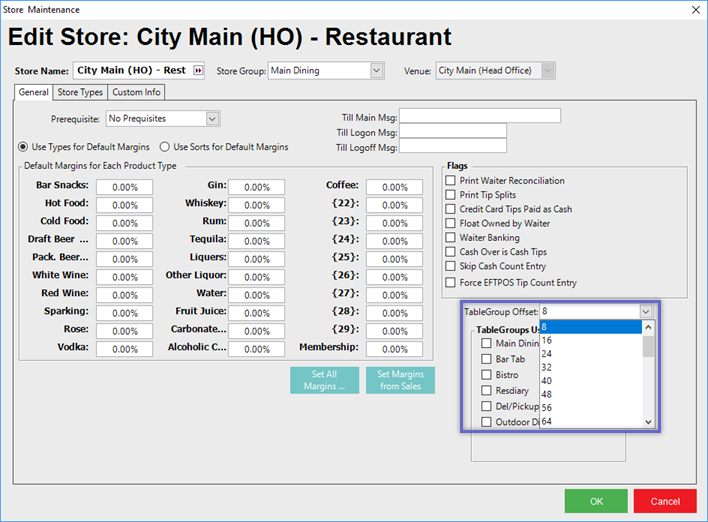
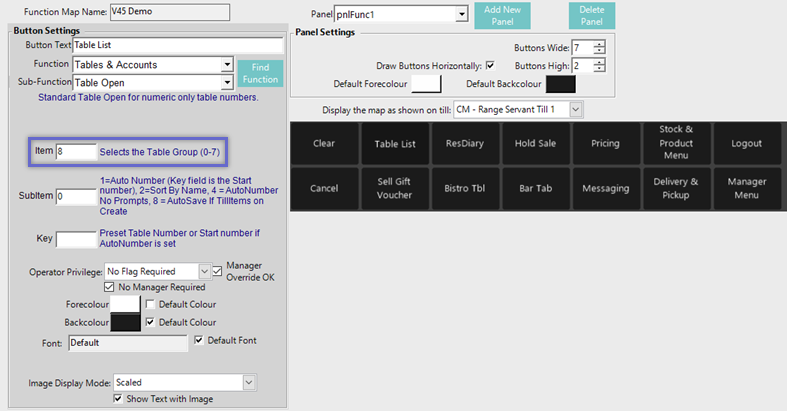
|
| TableGroups Used |
- The TableGroups Used section will list all of the Table Groups that are Named & configured in Venue Maintenance for the Store's Venue
- The flag next to each Table Group Name signifies whether or not that Table Group is used in the Store
|
|
